On the Road is a weekday feature spotlighting reader photo submissions.
From the exotic to the familiar, whether you’re traveling or in your own backyard, we would love to see the world through your eyes.
MollyS
In October, I went back to Paris to visit my daughter and son-in-law. While working on her Ph.D. in French literature, my daughter spent several summers and a few semesters in Paris. She met and married a terrific young Frenchman and they now live in the17th arrondissement, north of the world-famous attractions along the Seine.
For this visit, she and I decided to spend the weekend in Lyon, France’s second-largest metro area, some 245 miles southeast of Paris. Lyon was established by the Romans in 43 BC, where the Rhône and Saône rivers meet. The city became the capital of the Gauls during the Roman Empire. Today Lyon is a UNESCO World Heritage site and the gastronomic capital of France. And while the city was a world center for the production of silk, it’s also the home of the Lumière brothers, inventors of the modern cinemascope.
We spent most of our two days in Vieux Lyon, the city’s oldest section, located in the Fourvière district, across the Saôme. At the time we were there, 1 US dollar was about equal to 1 euro, which made shopping, eating, etc., a very good deal.
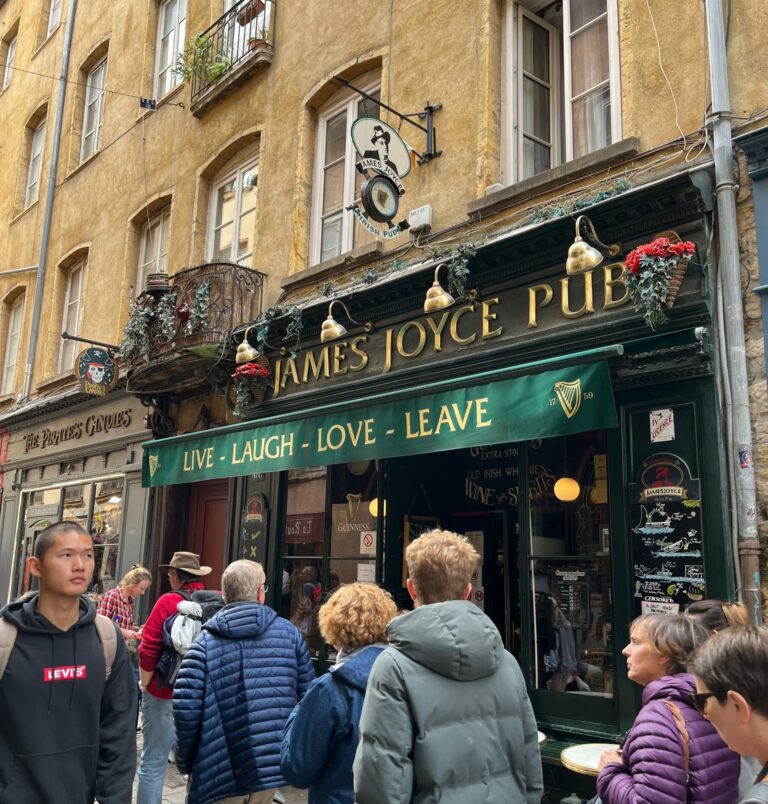
Joyce would have definitely approved of the pub’s motto!
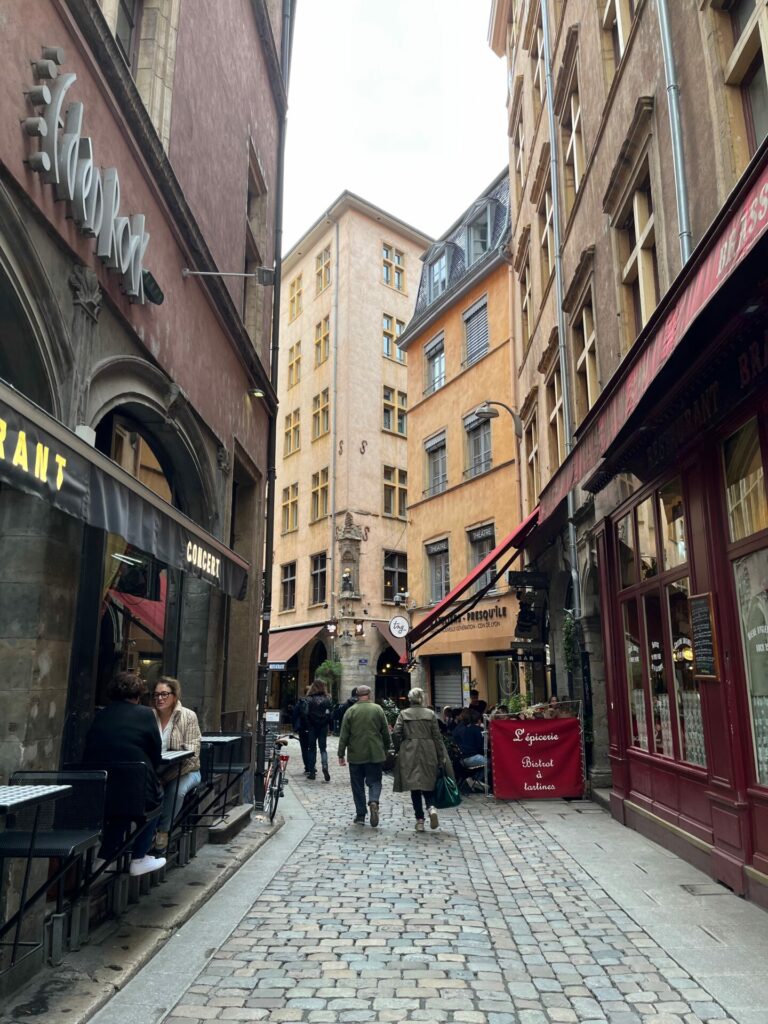
A typical street in Vieux Lyon, the oldest part of the city.
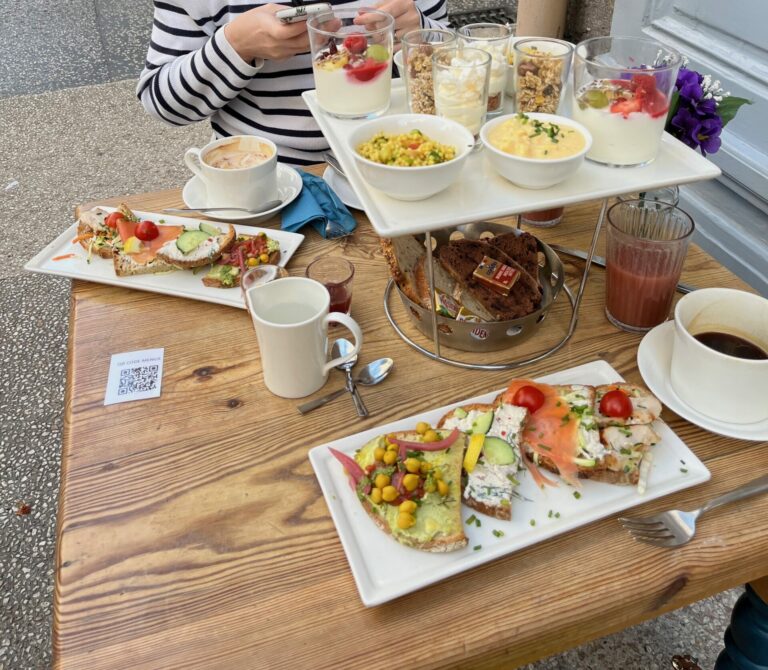
We started Sunday with brunch, and since it was only in the low 50s, the restaurant provided blankets on each chair for the outdoor diners. Brunch included yogurt and fruit, granola, 4 half sandwiches, couscous and another creamy veggie dish, several kinds of bread, mousse with crème Fraiche, and brioche aux praline, along with lots of great French coffee and a fruit smoothie.
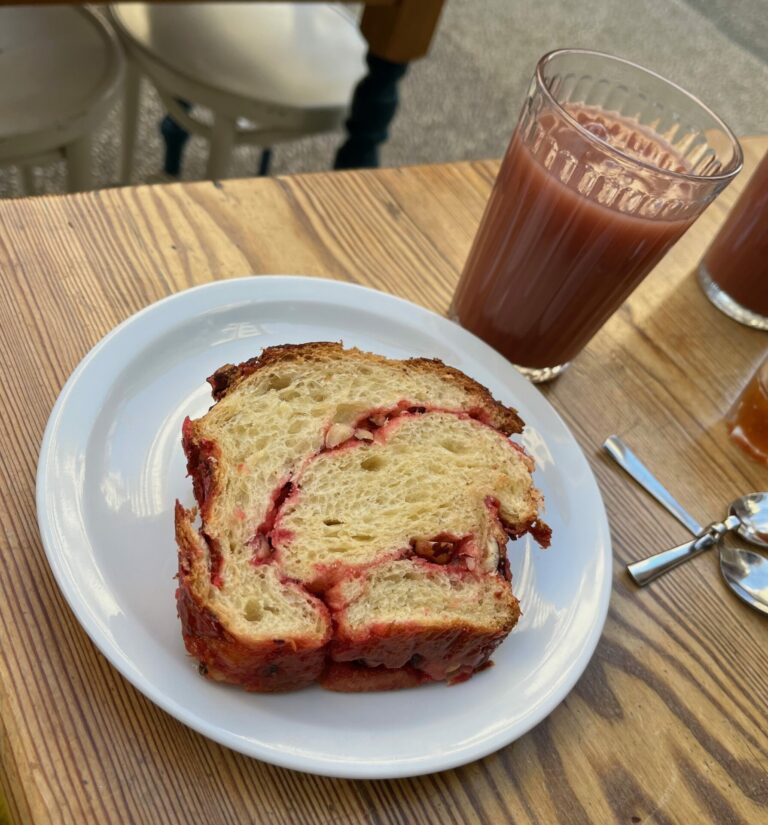
Lyon is famous for its pralines, chopped almonds coated with carmelized coated sugar, then dyed pink. Here the pralines are baked into a French breakfast brioche. But like the classic French baguette, brioche aux praline must be finished on the day they’re purchased …
While we didn’t try any of the gastronomic specialties that Lyon is famous for, on my son-in-law’s recommendation, I did order Lyonnaise quenelles. Quenelles are a kind of fish dumpling (traditionally, pike from the Saône), wrapped in panade, a dough made from flour, butter, eggs, and milk. The small dumplings are poached in broth, then topped with tomato, béchamel, or crayfish sauce and put in the oven for 15 minutes. Ils sont délicieux!
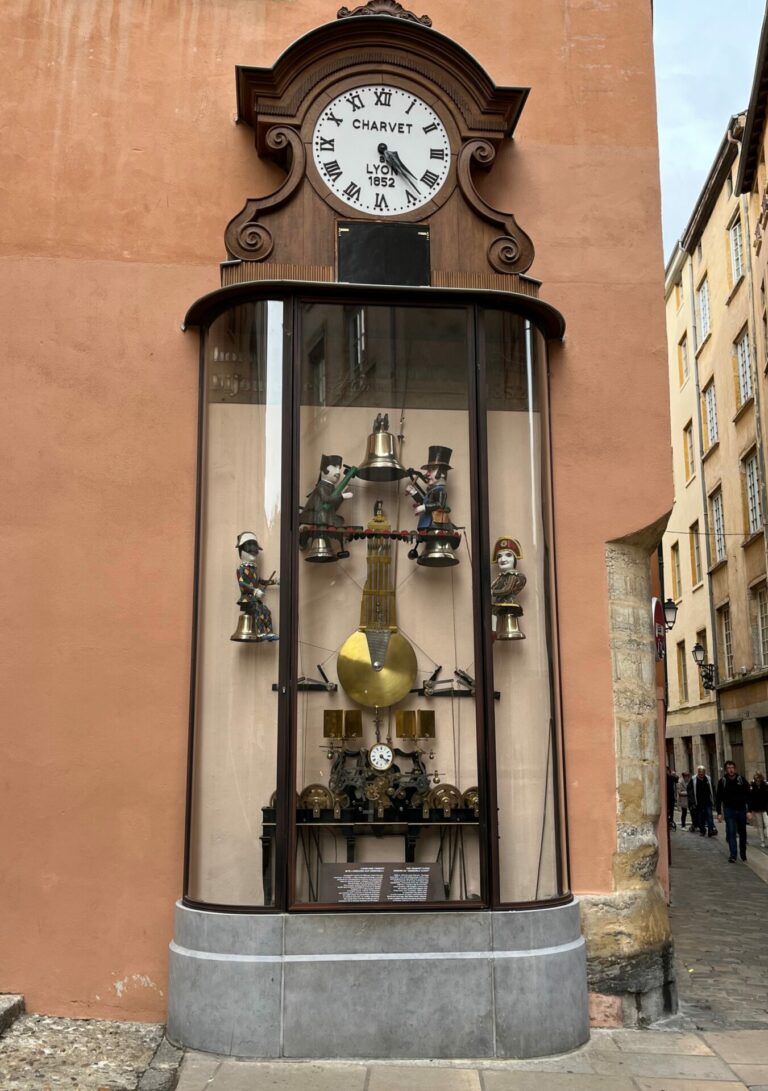
The Charvet clock, constructed by professional watchmaker Louis Charvet, was put in place on the rue de la Poulaillerie in 1864. In 2020, it was taken apart and restored, then moved to the entrance of the Renaissance-era hôtel de Gadagne. We waited about 20 minutes for the figures to begin ringing the various bells, as did a large crowd that gathered at the street corner. The hôtel has the largest courtyard in Vieux Lyon, spiral staircases, huge fireplaces, a painted ceiling, and the musée d’Histoire de Lyon, the Lyon History Museum, which we went through.
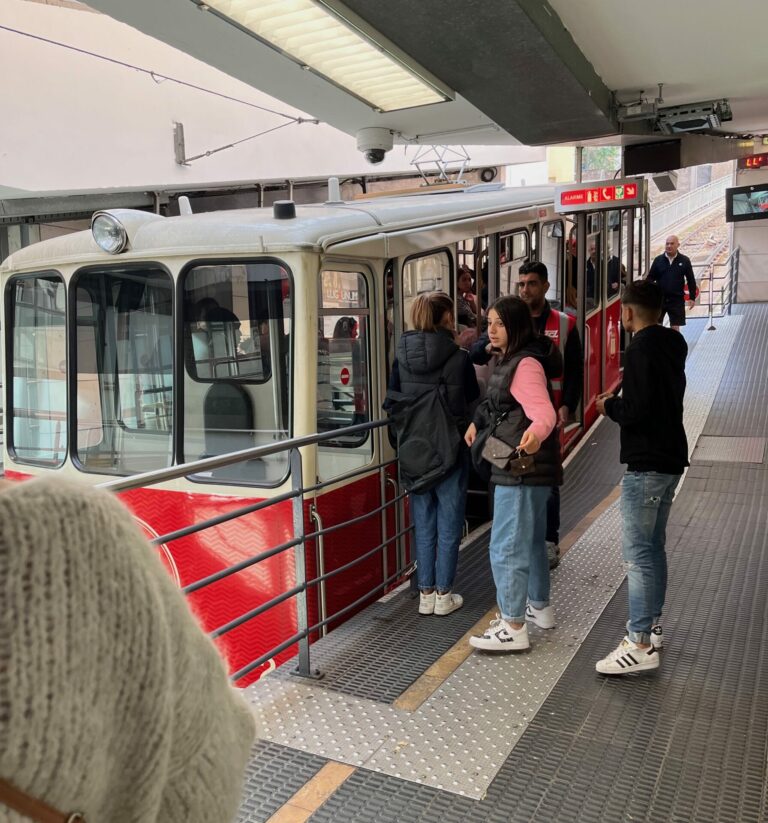
If you’re visiting a city built between two hills, you need to prepare for a lot of walking up and down. We wanted to go to the basilica of Notre-Dame de Fourvière, perched high above the city. Lyon’s city parents do need to invest in some better signage because we found no obvious signs saying “par ici,” or “this way to the big church.” We could see the massive building, but how to get up there? We did find a long steep road winding up the hill, but after watching several people stumble as they tried to maneuver back down, we decided to look for a funicular. A funicular is a very short railway, built on a steep incline. Lyon used to have five funiculars but only two are still operating. The one-way trip up the hill to the basilica was 2 euros.
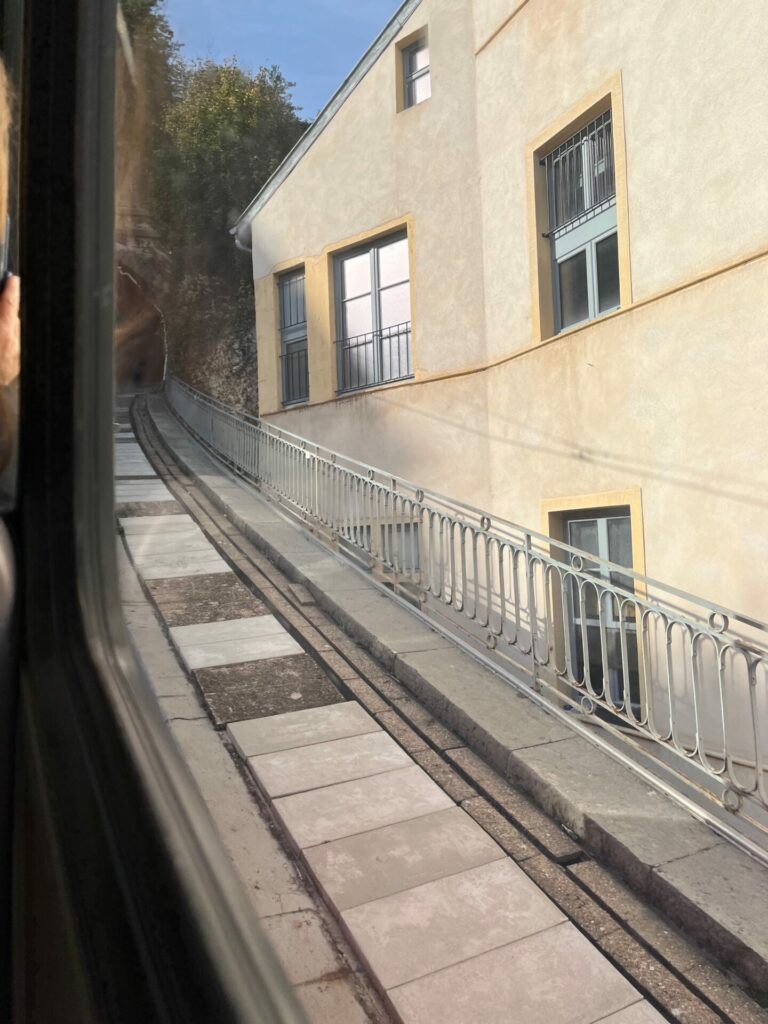
The path alongside the funicular, in case anyone still wants to walk up.
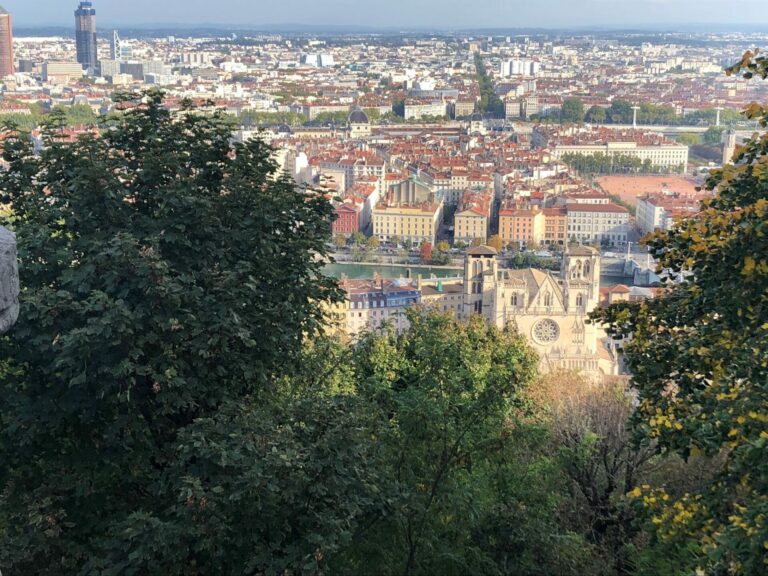
The basilica’s grounds are secured by a long fence (so no one tumbles down the steep hill) and provide some spectacular views of the city below. The ancient Gothic cathédrale Saint-Jean-Baptiste de Lyon is visible through the trees, as is modern-day Lyon, at the top of the picture.
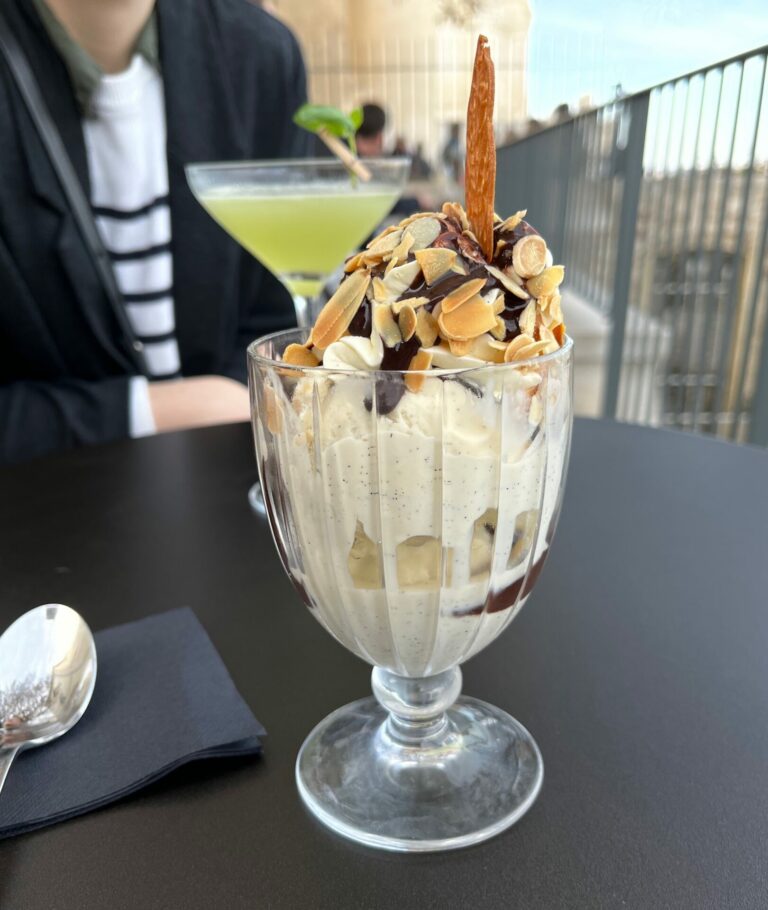
We decided to stop at the small café on the basilica grounds. I had a dame Blanche, or White Lady. Made with vanilla ice cream, thick warm chocolate sauce, toasted almonds, and a lot of whipped cream, it is similar to an American ice cream sundae. That’s an almond-based cookie sticking out the top. My daughter went for a basil-flavored alcoholic refreshment.
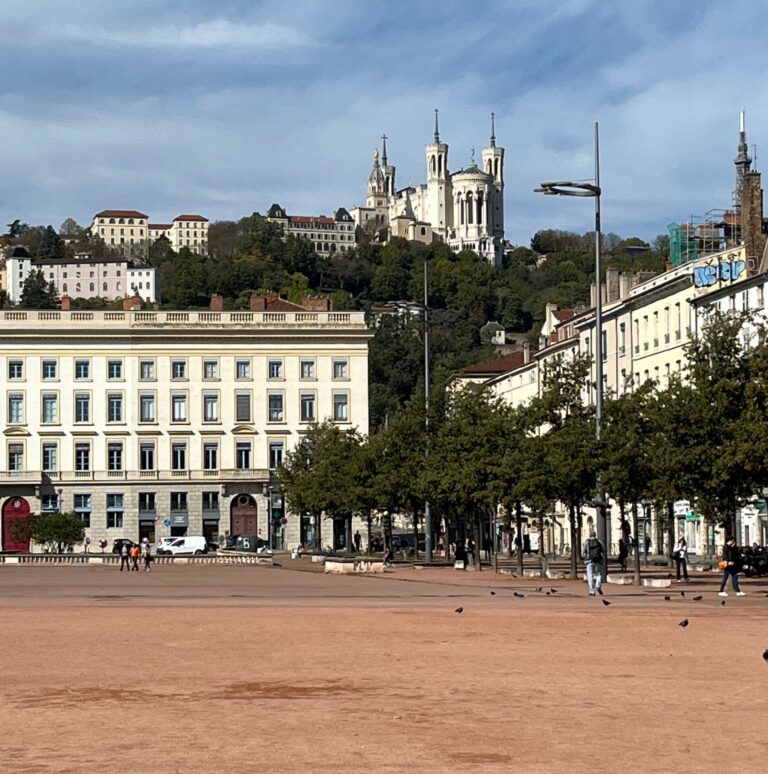
Back down at the bottom of Fourvière, at one end of le place Bellecour, Lyon’s city square, with the basilica rising high above. The place is huge, covering some 15 acres. The third largest such square in France (Paris’s place de la Concorde is about a third bigger), Bellecour is also the largest pedestrian-only public square in Europe.

HeartlandLiberal
Great pictures. The two of you ate so much I am surprised you could move at all. But I would have done the same. Wife and I are all about sampling the food on our travels.
Amir Khalid
I juust had dinner. Now I want a Dame Blanche for dessert.
Benw
So cool! Omg French coffee, so good. Reminds me of a quick trip to Paris with my fam. Thanks for sharing!
scribbler
@HeartlandLiberal: And here I was thinking how much lighter & healthier the French brunch seems when compared to the typical American brunch with its hash browns, pancakes, bacon, cheesy eggs…
Anyway
I was waiting for food pics from Lyon – ~thanks! Brunch looks killer. Love French coffee,
JPL
What lovely pics!
Lapassionara
Thanks for these photos. Mr LP and I spent a lovely week in Lyon several years ago, with an emphasis on food. I had one of the most amazingly good meals I have ever eaten, multiple courses. And the fish course was so good! On the other hand, some of the “specialties” of the area reminded me of bologna. Not horrible, but not appealing either.
Layer8Problem
Thanks for sharing these! I knew a very nice Lyonnais couple at a job many years back and photos like these make me wish I was still in contact. I’m considering how to organize a Dame Blanche for a late breakfast, but no chocolate sauce. Damn.
stinger
What wonderful photos and stories — thank you!
MelissaM
I love how you start with a “is this Lyon??” picture! And the brunch! Ooh la la!
JanieM
Oh, the food! I’m not big on pastries, so I’m not sure about the brioche, but the rest of it makes me want to get on a plane right now.
I once spent a beautiful Sunday afternoon in the city square in Brussels (called Grand Place) — lots of people strolling, eating, and enjoying a day of autumn sunshine. A nice institution, the city square!
Thanks for another nice set of pictures and stories.
MollyS
@scribbler: The brunch was fruit, grains, bread, eggs, yogurt, and one tiny slice of salmon … nothing fried, breaded, or heavily salted/processed. It’s hard to tell from the angle of the photograph, but the small bowls and glasses filled with different grains and custards were similar to our four-ounce glasses. The plain yogurt/fresh fruit was about the same amount, just in a larger container.
MollyS
@Amir Khalid: The Dame Blanche is the only oversized dessert I’ve encountered in France … almost all come in small portions. A slice of pie or cake will be maybe half to two-thirds of what we would get at an American restaurant.
MollyS
@MelissaM: Joyce lived in Paris for 19 years. His good friend, Sylvia Beach, owned the Shakespeare and Company bookstore in Paris (a wonderful place to visit today) and was the first publisher of Ulysses, in 1922.
Embra
As I was scrolling through the wonderful photos, I didn’t have my depth cues squared away on the dame Blanche shot. I was going with your daughter as a relative size cue for your drink AND IT LOOKED GINORMOUS!
way2blue
MollyS. Your first two photos look straight out of a movie.
Love the old town streets in Europe. There’s something welcoming about them—like well worn, well loved clothes.
pieceofpeace
Always thought (and wanted) a move to France would be to Lyon, which I still might do!
Thanks for these and the reasons to dream big…
J R in WV
We spent a long couple of weeks in Basque country visiting archaeological sites mostly related to ancient paintings in caves. The AIA tour started out in NE Spain, then wound up in Toulouse, where the old part of the city looked much like the second photo in this wonderful set. We met and shook hands with several world-famous archaeologists at several world-famous locations.
Our hotel was on the actual site in France where Cro-Magnons were first described scientifically.
Then we took a train to Paris, where we had two evening meals, the first at a mostly seafood shop/restaurant near the Louvre and the second at a Michelin starred place just across the river from the Eiffel tower.
The first one was great ordinary French food, the second evening dinner was amazing. We did 2 bottles of champers with a 2 or 3 hour dinner. Was so glad I used my little tablet computer to find a well-reviewed Michelin starred restaurant that actually had room to seat a couple of folks the very next day. Was a peak French culinary experience. No one was offended by our lack of French language skills, perhaps because we were so obviously loving France!
I hope to recover well enough to visit France again, and Italy, and Switzerland, where my paternal grandfather’s parents came from. I must still have cousins there, although I have no idea how I would go about finding them. Granddad took his whole family to Europe in part to meet the Swiss branch of his family, in 1938. Amazing stories of the intro to WW II…
MollyS
@Embra: If you look at the spoon on the left, you can get a better sense of the size of the ice cream and drink. The Dame Blanche had two small (European-sized) scoops of ice cream and a lot of whipped cream. I have another picture that gives a better sense of the sizes … will ask WaterGirl if it can be posted.
MollyS
@pieceofpeace: Visit first! Americans can go to France for three months, no visa required, just a passport. I’d always choose Paris first, but Lyon is definitely in second place.
MollyS
@J R in WV: All my many Paris dinners have been in small neighborhood restaurants where the quality of the food is amazing. Tourists rarely venture into the areas where Parisians live—and eat … the same terrific food but at non-tourist prices.